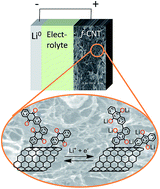Covalently functionalized carbon nanotubes as stable cathode materials of lithium/organic batteries†
Abstract
Lithium batteries are among the most promising systems for electrochemical energy storage. However, their capacity and cost-efficiency have to be improved for further applications, for instance in electric vehicles. In this context, lithium/organic batteries offer an interesting alternative to the classical Li-ion systems. Indeed, organic materials offer a high electrochemical activity depending on their functional groups and can be cost-effective if their synthesis is simple and well-controlled. The major problem of the lithium/organic systems developed so far is the progressive dissolution of the active molecules in the electrolyte upon cycling, leading to poor capacity retention. In this work, new positive electrode materials avoiding the dissolution of the active material in the electrolyte upon cycling are developed, by grafting anthraquinone diazonium salts to carbon nanotubes. Carbon nanotubes are used both to bring electronic conductivity to the positive electrode and to serve as a support for covalent immobilization of the active material. The resulting systems remain very stable over prolonged cycling (80% of the initial capacity retained after 500 cycles) and present a promising specific capacity in the range of 100 mA h gelectrode−1.


 Please wait while we load your content...
Please wait while we load your content...